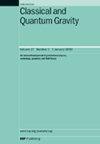用恒星正确运动测量模糊暗物质的玻色子质量
IF 3.6
3区 物理与天体物理
Q2 ASTRONOMY & ASTROPHYSICS
引用次数: 0
摘要
模糊暗物质(FDM)是取代wimp和解决暗物质之谜的最合适的候选者之一。由这些超轻玻色子粒子组成的星系DM光晕形成了一个被量子干涉图案包围的孤子核,平均而言,在光晕的外围重现了一个类似纳瓦罗-弗兰克-怀特的质量密度曲线。一旦确定了玻色子的质量和光晕的总质量,这样一个核心的结构就确定了。我们研究了未来类似theia的天体测量任务的能力,以探测FDM模型中这种晕的性质,即玻色子质量和核心半径。为此,我们建立了模拟星表,其中包含目标矮星系内恒星的三维位置和速度。我们利用马尔科夫链蒙特卡罗算法对这些星表进行了分析,发现测量目标星系内至少2000颗恒星的固有运动,在速度分量上不确定km s−1,将以3%的精度约束玻色子质量和核心半径。此外,可以以7%的不确定度检测到孤子核和最外层nfw样密度剖面之间的转变。这样的结果不仅有助于确认FDM的存在,而且还有助于缓解目前星系和宇宙学对玻色子质量的估计之间的紧张关系,或者证明在自然产生的弦轴宇宙中需要具有广泛质谱的多个粒子。本文章由计算机程序翻译,如有差异,请以英文原文为准。
Measuring the boson mass of fuzzy dark matter with stellar proper motions
Fuzzy dark matter (FDM) is among the most suitable candidates to replace WIMPs and to resolve the puzzling mystery of dark matter (DM). A galactic DM halo made of these ultralight bosonic particles leads to the formation of a solitonic core surrounded by quantum interference patterns that, on average, reproduce a Navarro-Frenk-White-like mass density profile in the outskirts of the halo. The structure of such a core is determined once the boson mass and the total mass of the halo are set. We investigated the capability of future astrometric Theia-like missions to detect the properties of such a halo within the FDM model, namely the boson mass and the core radius. To this aim, we built mock catalogs containing three-dimensional positions and velocities of stars within a target dwarf galaxy. We exploited these catalogs using a Markov Chain Monte Carlo algorithm and found that measuring the proper motion of at least 2000 stars within the target galaxy, with uncertainty km s−1 on the velocity components, will constrain the boson mass and the core radius with 3% accuracy. Furthermore, the transition between the solitonic core and the outermost NFW-like density profile could be detected with an uncertainty of 7%. Such results would not only help to confirm the existence of FDM, but they would also be useful for alleviating the current tension between galactic and cosmological estimations of the boson mass, or demonstrating the need for multiple particles with a broad mass spectrum as naturally arise String Axiverse.
求助全文
通过发布文献求助,成功后即可免费获取论文全文。
去求助
来源期刊

Classical and Quantum Gravity
物理-天文与天体物理
CiteScore
7.00
自引率
8.60%
发文量
301
审稿时长
2-4 weeks
期刊介绍:
Classical and Quantum Gravity is an established journal for physicists, mathematicians and cosmologists in the fields of gravitation and the theory of spacetime. The journal is now the acknowledged world leader in classical relativity and all areas of quantum gravity.
 求助内容:
求助内容: 应助结果提醒方式:
应助结果提醒方式:


